Now that we’ve reviewed four basic types of motivation, it’s time to put them together and have a look at the big picture. Have a look at the diagram above, which is composed of two axes: intrinsic-extrinsic; personal-interpersonal.
Motivation is usually complex, so that any given task or project involves several different types of motivation. You may love your work for its own sake (intrinsic), but that doesn’t mean you will be put out if your monthly pay cheque doesn’t arrive (extrinsic). You may have a strong natural curiosity or need for self expression (personal), but that doesn’t mean the presence of encouragement and all competition from colleagues won’t prompt you to redouble your efforts (interpersonal). And you’ve probably already noticed that different types of motivation can shade into one another. For example, recognition has appeared twice, under extrinsic and interpersonal motivations, since it’s a form of reward that involves the opinion of other people.
For any given person, task, project or organisation, it’s possible to assess types of motivation as well as their relative importance, for each of the four quadrants.
For example, one person may have high levels of personal intrinsic motivation, valuing challenge meeting and learning in their work. They may also be strongly motivated by interpersonal intrinsic factors, such as a sense of contributing to the field. Personal extrinsic may be relatively unimportant — as long as they have enough to pay the bills, it’s not a big issue. But interpersonal extrinsic is relatively high, since they value their professional reputation and the status it brings them.
In the rest of this post I’ll look at each of these quadrants in more detail.
Personal satisfaction (personal intrinsic)
In this quadrant people are motivated by satisfaction in the work itself, as well as the alignment of the work with their own core values. Here we find the poet entranced with the magic of words and authentic self-expression. We also find the engineer who loves learning and adding to her store of knowledge she grapples with a difficult challenge.
Pros This is probably the quadrant that has the most influence on the quality of work — without personal motivation or intrinsic satisfaction in the task, people are unlikely to achieve outstanding results.
Cons Because of the intensely personal nature of this kind of motivation, there is a danger that the results will have little relevance to others. The self absorbed poet who doesn’t trouble to read others’ work is unlikely to produce great poetry. And in a business context, it’s essential that people don’t work on pet projects to their own criteria, losing sight of organisational goals.
Social interaction (interpersonal intrinsic)
In this quadrant people are influenced by each other. ‘Social interaction’ can refer to the simple attraction of being with other people, as in “it’s nice to get out of the house for a bit of social interaction”. It also refers to the give and take social exchange, including altruistic motives, pleasure from others’ company, and the attraction of wielding power and influence. Here we find the mavens who love to connect others and social entrepreneurs who want to use their skills for the benefit of the community.
Pros Creators who regularly interact with their peers, customers and/or audience are much more likely to produce something relevant and socially valued than the proverbial artist in the garret or ivory tower thinker.
Cons Generosity and influence are both double-edged swords: the former carries a risk of neglecting your own interests and gifts, the latter can lead to harming others.
Personal rewards (personal extrinsic)
This quadrant is about ‘What’s in it for me?’. It’s about making sure you don’t come away from a project empty-handed. It’s also about insuring yourself against negative consequences. This is where we have frank talks about salaries and remuneration. It’s also where agents and lawyers stepping to argue vigourously for individual interests.
Pros Strike a deal that satisfies all parties and it will enhance mutual respect and commitment. It also helps everyone avoid a world of stress and wrangling that can have devastating effects on performance.
Cons Personal rewards are necessary-but-not-sufficient to produce outstanding creative work. So if your motivational strategy consists of throwing money at the problem, you’re in trouble. And if you’re a creative, you’re unlikely to produce anything remarkable if you’re only in it for the money. Both leaders and team members neglect the other three quadrants at their peril.
Public recognition (interpersonal extrinsic)
In this quadrant people are concerned about their public image. They are motivated to boost or protect their reputation. This is the realm of awards, prizes, blockbusters and letters after your name. It’s where the critics sharpen their pencils and the crowd loads up with confetti or rotten fruit.
Pros Many creatives are far more motivated by public recognition than by money. So even if you have a tight budget, there are plenty of ways to get people fired up by offering recognition for their achievements.
Cons If you spend too long chasing the ratings then you risk losing touch with your own creative passion (personal intrinsic) and delivering real value (interpersonal intrinsic). The irony is, discerning audiences can spot a fake, and will lose respect for you if you try to anticipate and pander to their every wish.
A Matrix of Creative Motivations
We can sharpen up the picture by looking at the various motivations purely in relation to creative work:
Note that the only quadrant with a purely negative connotation for artists is personal reward (‘selling out’). Yet it’s often the one that managers and leaders focus on the most when trying to motivate people.
If you’re a leader, manager, creative director or otherwise involved in facilitating creative work, and you take one thing from this series I’d ask you to focus at least as much energy on each of the other three quadrants as on the bottom left one. They are where you have the biggest chance of success — and where everyone is likely to taste the greatest satisfaction.
Is Your Current Enterprise Sustainable?
For any project, career organisation to succeed, it needs to cover all four quadrants. The balance between them can be wildly different, but if any of the four motivations is completely absent, it will be hard to sustain the necessary commitment when things get tough.
Hence the mid-life crisis when someone realises they can’t spend the rest of their life doing a job that conflicts with their personal values. (Think Richard E. Grant in How to Get Ahead in Advertising.) Or the cash crisis in a business driven by creative enthusiasm that neglects financial safeguards. (Think Factory Records.) Or the crisis of confidence in an artist who fails to receive the recognition he craves. (Think Van Gogh.)
Which quadrants are most/least important to you personally?
Which quadrants are most/least important to your organisation?
Are you sure you can carry on doing what you’re doing?
With thanks to Chris Bilton and Ruth Leary of the MA in Creative and Media Enterprises at the University of Warwick, for a discussion that was very helpful in formulating this model.
Read the book
For in-depth practical guidance on harnessing motivation in your creative career, read Mark’s book Motivation for Creative People

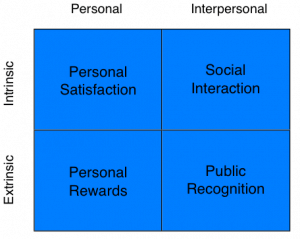
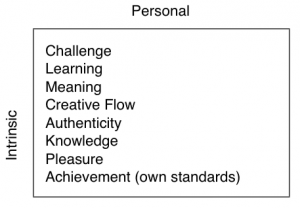
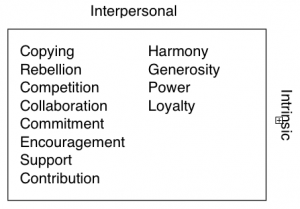
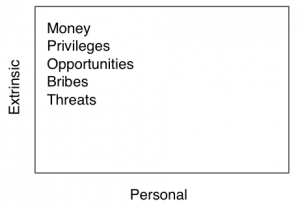
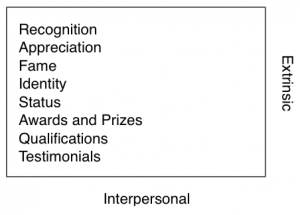
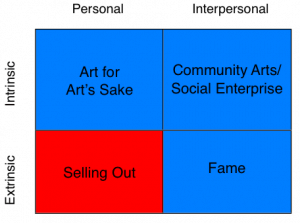

[…] Fiducia eccessiva sulla compensazione come strumento di gestione. Come spiegato nel post precedente che parla di principi di Deming, la gestione per obiettivi dati alle singole persone può essere dannosa per l’organizzazione. E poi ci sono tanti sistemi di compensazione alternativi (non in denaro) che (ciò è dimostrato a lungo nei trattati di psicologia) risultano molto più incentivanti rispetto al premio in denaro. Per spiegarvi qualcosa di più riguardo i metodi di motivazione estrinsechi e intrinsechi, leggete la seguente serie di articoli sul sito di Wishful Thinking: Come motivare le persone creative, La gioia del lavoro, Premi per il lavoro, Valori personali, Pressione degli altri e Trovare il giusto equilibrio. […]